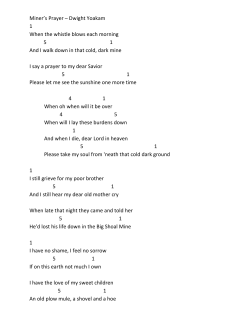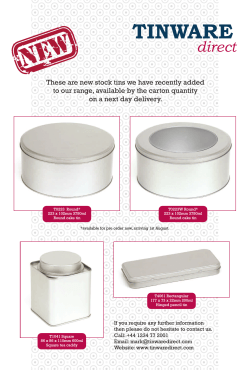
Tin-Fields of the federated Malay State : methods of working
JB 1285 • • ,..... . Ie s 0/ the - e era e a es • METHODS OF ORI(ING • (I LL USTRATED ) BY J. B. SCRIVENOR Govenl lllent Geo logist, F.M.S. PERPUSTAKAAN NEGARAMALAYSI A • • MINING PUBLICATIONS, LTD., 72 4, SAL ISBURY • HOUSE, L ONDON, E . C . 2 . 817054 / • • • • • • Fig. 1 is a view of the Perak River near its source, Howing through dense jungle on either bank. In this jungle it is rarely that one can see farther than a hundred yards or so. The mining land near Kuala Lumpur was once covered with equally dense jungle, which has now been felled and destroyed, leaving a broad plain open to the heat of the tropical sun. Fig. 2 shows the effect that the work of man has had on the Malay Peninsula, once covered by virgin forests. • PERPUSTAKAAN NEGARAMALAYSI A • • -3- • , • 1. IN VIRGIN JU GLE. I • • PERPUSTAKAAN NEGARAMALAYSI A 2. MINING LA D NEAR KUALA LUMPU R. - • Fig. 3 shows a group of Chinese women cleaning rough concentrates of ore by washing them in wooden pans. This is the mos~ primitive method of dressing ore, but thanks to the skill attained by the workers it is effective. This washing in pans is largely used by Chinese and Malays to save the small amounts of tin that escape concentration on the mines and are washed away with the lighter grains or tailings," and accounts for a large amount of tin ore annually. In the foreground are some half.. coconut sheHs whkh are largely used by miners for con~ centrating small samples of ore. 1/ - Fig. 4 is of a small ground~sluicing mine or lampan in which the water, seen falling in a small cascade on the right, is brought to the ore. The two Chinamen are breaking up the soft tin~bearing ground with crowbars. It falls into the stream, where the water carries oft the lighter constituents, leaving a con~ centrate of tin ore with heavy impurities which are separated later. PERPUSTAKAAN NEGARAMALAYSI A - 4 • • • -- - - • 3. CH INESE WOMEN CLEAN I NG TIN ORE. PERPUS T A K A A N NEGARAMALAYSI A ,• • ( - • 4. • • A SI\ I ALL CH I ESE LANPAN. • Ground. . sluicing can most readily be employed in hilly country where the steep slopes make it easy to conduct small streams of water wherever they are required. In Fig. 5 we see the effect of ground, sluicing on a large scale in the mountains. The jungle has been felled and the water has washed away all the soil and light sand, leaving a jumbled mass of huge boulders. Although such ground does not look promising for vegetation, it is surprising how soon a rank growth appears on it again. In some places old lam pans such as this stretch for miles in the valleys and make rapid progress on foot impossible . • • • Fig. 6. Where big boulders are numerous the mountain streams effect a natural concentration of tin ore under them, and as this is very rich ground, the Chinese burrow under the boulders to win it, after diverting the stream if there is so much water as to make the ore inaccessible. The removal of the sand destroys the support of the boulders, and they have to be propped up with timber; but as the Chinese are careless about choosing props strong enough to bear the weight, it sometimes happens that the boulders fall and crush the miners underneath. PERPUSTAKAAN NEGARAMALAYSI A -5- 5. THE EFFECT OF GROUND-SLUICING IN THE MOUNTAINS. PERPUSTAKAAN .. G NE ARAMALAYSI A .-- - 6. PART OF A LAMPA V SHOWING BOULDERS SUPPORTED BY WOOD. • • • Fig. 7 is of a small Chinese open,cast mine or lumbong . The Chinese coolies are digging up tin,bearing gravel which has been laid bare by the removal of valueless sand and day, seen in section on the far and right sides of the mine. The tin, bearing gravel is placed in sha1l0w baskets, two of which are slung on a strong flat wooden staff which the coolie puts across his shoulders and carries off to the place where the ore is concentrated. Fig. 8 is of a similar mine showing a light timber,work gangway, and two coolies baling water from the bottom of the • mine to a higher level by means of a bucket slung on ropes. PE R P U S T A K A A N NEGARAMALAYSI A • • -6- ~, , • ., 7. - . • ' .. A SMALL OPEN·CAST, MINE. , -- • PERPUSTAKAAN NEGARAMALAYSI A • • • 8.-A SMALL OPEN·CAST MI NE. • Fig. 9. shows dark~c1ad Chinese women working on an open~cast mine. They are removing earth from the mine by means of two narrow gangways, one for ascending, the other for descending. These gangways are made of tree~trunks in which shallow steps are cut. They are frequently placed across considerable heights, and, for a booted European, are not pleasant to cross. It will be noticed that the women's clothes are by no means scanty, and it is extraordinary how they can move heavy loads of earth about in such garments under a tropical sun and in a pit where no cooling breeze can blow. • • Fig. lOis interesting because it shows three Chinese tin~mining operations at work close together. At the bottom of the mine on the left is a pool of slushy tin~bearing sand, clay and water. Near the top, on the left also, is a washing~box under a thatch roof where the tin ore in the slush is concentrated. The slush is conveyed from the mine to the washing~box by being' ladled up a series of little puddles cut in the side of the mine as shown in the photograph. In the centre of the mine is a Chinese pump worked by men on a roughly made treadmill under the awning. The pump consists of a series of small wooden boxes made to travel over two wheels, one at the top, the other at the bottom of the mine. The boxes descend with their openings downwards, turn as they pass round the wheel at the bottom and at the same time fill themselves with water, then travel up full, and empty themselves as they turn over the top wheel to go down again . PERPUSTAKAAN NEGARAMALAYSI A • -7- •
© Copyright 2025














